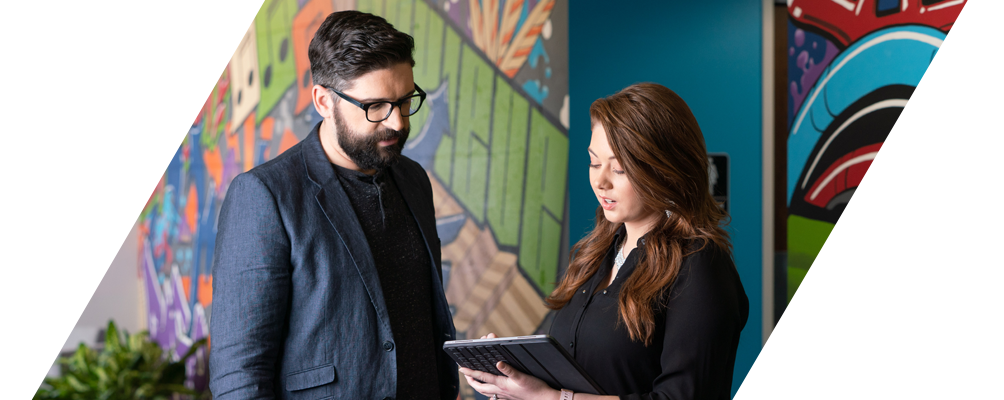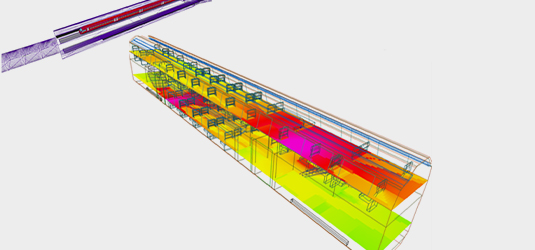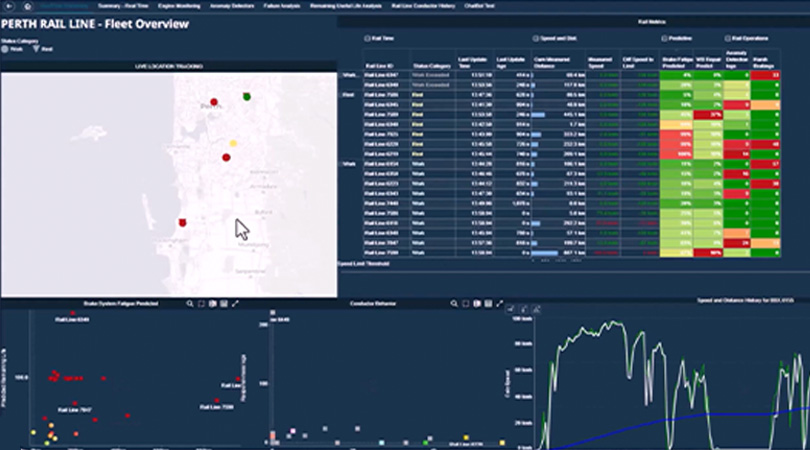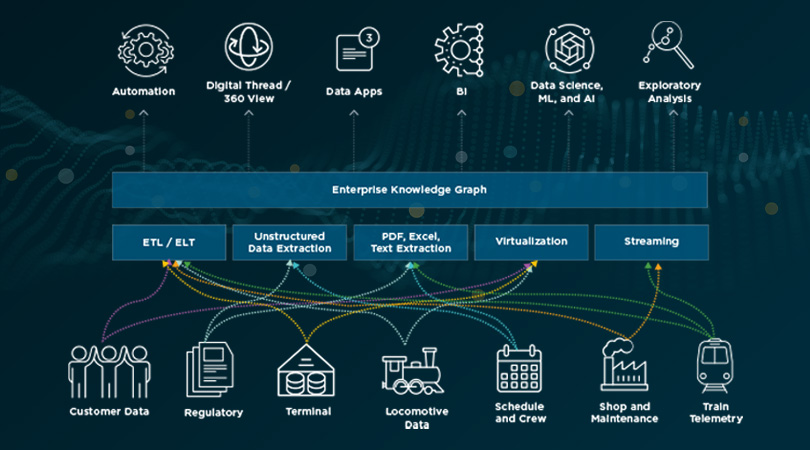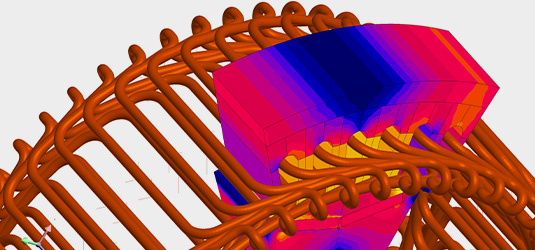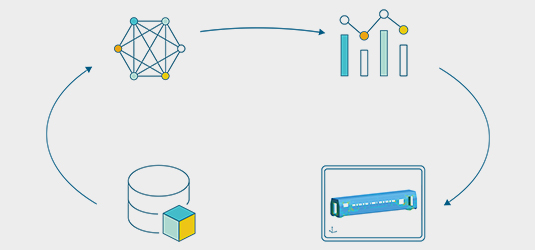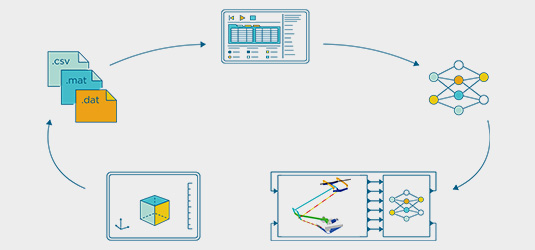
Accelerate Rail Innovation
The rail industry is under pressure to deliver safer, more efficient, and more connected systems. Whether you're designing the next generation of rolling stock or optimizing network operations, Altair supports every step of your journey toward smarter rail solutions.
For OEMs, our cutting-edge simulation, artificial intelligence (AI), and high-performance computing (HPC) tools accelerate development, reduce physical prototyping, and ensure global compliance – validating critical performance metrics like fatigue life, crashworthiness, thermal behavior, and vibration control early in the design process.
For operators, Altair’s AI fabric and machine learning solutions transform operational data into actionable insights – improving asset reliability, enabling predictive maintenance, and enhancing efficiency through real-time monitoring and smart decision-making. Intuitive knowledge graph technology helps serve as a foundational data interoperability tool for rail operators looking to create data fabrics with ontology-based solutions.
From design to deployment, Altair empowers the rail industry with innovative, data-driven technologies that drive performance, reduce costs, and create a safer, more sustainable future of railway design.
Tools to Improve Efficiencies and Reduce Downtime
From grid to rail – electrification remains a crucial focus in rail design, driving efforts to reduce carbon emissions. Gaining critical insights earlier in the design process is essential to align energy efficiency and sustainability demands with the industry’s high standards for performance, passenger comfort, and reliability.
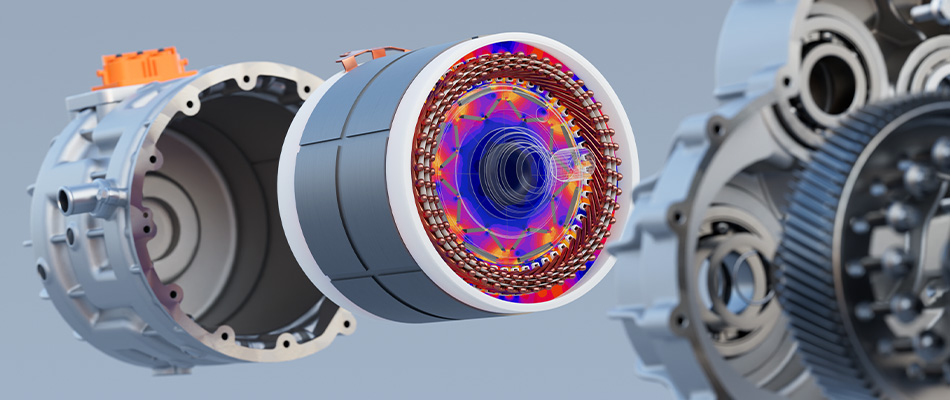
Efficient Electric Drivetrains
Altair® SimLab®’s multiphysics capabilities empower rail engineers with advanced electromagnetic, thermal, and structural simulation tools that reduce weight, enhance energy efficiency, and develop compact systems with optimized cooling strategies to ensure reliable performance even in extreme climate conditions.
Altair® FluxMotor® enables simulation-driven design of electric rotating machines, allowing engineers to build concepts from standard or customized parts, optimize windings and materials, and assess machine performance across multiple physical domains. This comprehensive approach accelerates development, striking the right balance between efficiency, size, and cost to deliver higher-performing traction machines for modern rolling stock.

Power Transformation
Designing railway transformers presents complex challenges – from managing heat in confined spaces and ensuring electromagnetic compatibility (EMC) compliance, to meeting strict size, weight, vibration and durability requirements. Engineers must optimize electrical, thermal, and structural performance while minimizing noise and complying with rigorous railway standards.
Altair SimLab addresses these through integrated multiphysics simulation, enabling efficient, reliable, and compliant transformer designs. Paired with Altair® Flux®, teams can simulate magneto-static, steady-state, and transient behaviors — balancing efficiency, cost, size, and thermal management.

Power Electronics
Traction inverters in modern rolling stock must operate under demanding conditions including high voltages and currents, regenerative braking, fault scenarios, and variable loads. These challenges require precision-engineered simulation tools.
Altair® PSIM™ is a purpose-built power electronics environment, outperforming general-purpose simulators in modeling high-frequency power stages and their controls. It supports detailed modeling of IGBTs, SiC, and GaN devices, including their non-linearities, thermal losses, and EMC — critical for achieving the efficiency, reliability and safety required in rail systems.
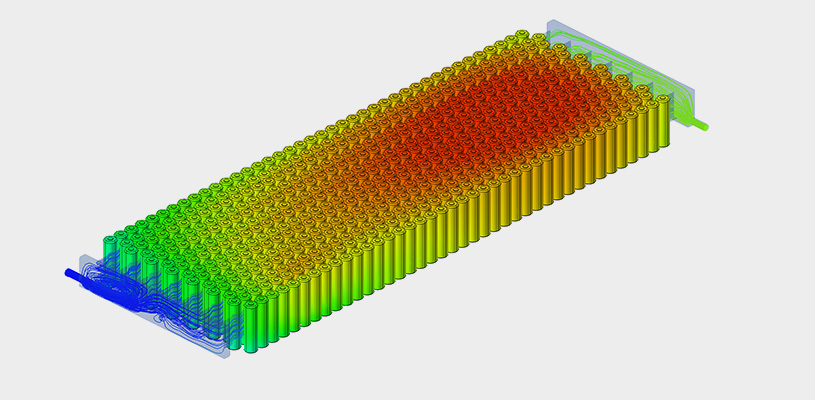
Battery Solutions for Next-Gen Rail Mobility
As the rail industry transitions toward cleaner, more efficient propulsion systems, battery-powered mobility plays a key role. Altair’s battery design and simulation solutions offer a comprehensive, end-to-end approach – from concept development to full system optimization.
Altair’s integrated, multiphysics workflows help engineers navigate complex trade-offs between performance, safety, cost, and sustainability. With built-in digital twin capabilities, Altair enables real-time health monitoring and predictive insights across the entire battery lifecycle, enhancing reliability, extending service life, and supporting smarter decision-making at every stage of rail design.
Optimizing Connectivity and Passenger Experience
Ensure seamless connectivity and enhance passenger safety with advanced wireless network planning. Altair empowers rail operators to design robust communication systems that keep trains, tunnels, and stations reliably connected – above ground and below.
Passenger Environment
Enhance passenger comfort using Altair® OptiStruct® for noise, vibration, and harshness (NVH) analysis, and Altair® Squeak and Rattle Director™ for interior quality. Altair® CFD™ improves airflow and thermal comfort in compartments.
Reliable Connectivity in Every Rail Environment
Altair® WinProp® enables accurate planning and deployment of antennas and leaky feeder cables in detailed 3D environments, ensuring reliable coverage where it’s needed most.
Smarter Design with Proven Simulation Tools
Complement network planning with powerful electromagnetic and system simulation. Design and simulate EMC and antenna performance with Altair® Feko®, maximize coverage and network efficiency with Altair® WRAP™, and analyze magnetic fields and optimize sensor performance with Altair Flux.
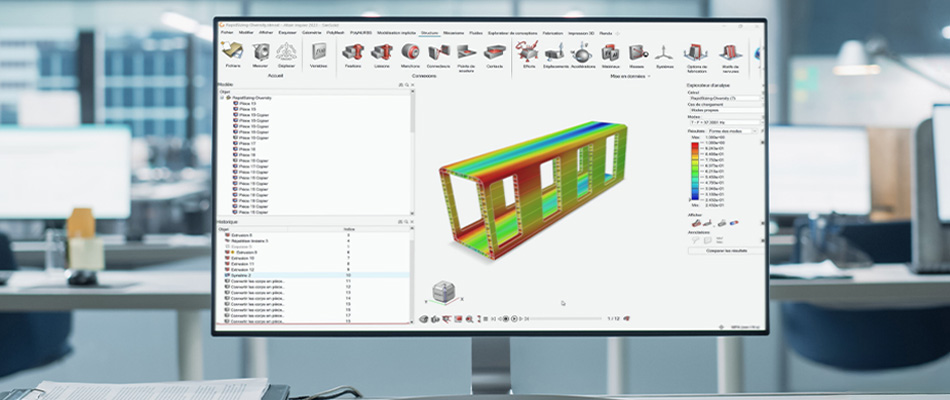
Accelerate Virtual Prototyping for Rolling Stock
Rail OEMs need to respond rapidly during the tender phase with flexible, cost-controlled modular platforms. Altair® SimSolid® eliminates traditional finite element analysis (FEA) bottlenecks – no meshing, minimal model prep – and allows tender teams to evaluate design changes and customer requests in minutes. This accelerates customization, improves cost control, ensures compliance, and dramatically reduces turnaround time from weeks to hours.
Smarter Rail Systems Start with Altair
Transform the Rail Industry with Intelligent AI Agents
As the rail industry evolves to meet growing demands for safety, reliability, and operational efficiency, leveraging advanced AI and data analytics is critical to maintaining a competitive edge. Altair® RapidMiner®, built on Altair’s powerful AI fabric framework, empowers rail manufacturers to tackle complex challenges with intelligent, scalable solutions. By integrating real-time data with AI agents, Altair equips engineering and operations teams with the tools to make faster, data-driven decisions – maximizing asset utilization and enhancing performance across the entire rail ecosystem. Modular architecture and flexible deployment options ensure scalable, secure, and future-ready railway software with AI that delivers lasting value on existing technology investments.
Enable Data Interoperability with Knowledge Graphs
Managing supply chains, ensuring regulatory compliance, and planning network expansions in the rail industry is complex – especially with siloed data. Knowledge graphs connect data across systems and sources, providing real-time visibility, optimizing asset utilization, supporting regulatory compliance, and enabling smarter, data-driven expansion.
Interested in accelerating your weld certification?
Learn MoreStructural Integrity and Multiphysics Train Simulation
Industry-leading FEA Solutions
Railway OEMs require robust design optimization and certification workflows. Altair OptiStruct is the industry leader in railway FEA because it unifies advanced simulation capabilities, including linear, nonlinear, explicit, and multiphysics. Its ability to integrate electromagnetic, thermal, fatigue, and structural domains in a single environment gives it a decisive edge in addressing the complexity of modern rail vehicle engineering.
Optimization for Lightweight Design
Rail components must strike a balance between lightweight design for energy efficiency and the structural strength required to withstand heavy loads and fatigue. Altair OptiStruct optimizes bogie structures, interior mounts, and car bodies. Its integrated topology, size, shape, and topography optimization capabilities help reduce material usage while maintaining essential stiffness and long-term durability.
Electromagnetic-Thermal-Structural Coupling
In traction motors and eddy current braking systems, heat generation and electromagnetic forces significantly impact structural integrity and component lifespan. By coupling Altair OptiStruct with Altair Flux, engineers can accurately simulate electromagnetic heating and Lorentz forces. These computed loads are then applied to the structural model to perform thermal stress and deformation analyses, ensuring the thermal stability and durability of both electronic components and mechanical structures.
Crashworthiness and Safety Analysis
Rail vehicles must meet stringent crashworthiness standards such as EN 15227, which require the simulation of large deformations, complex contact interactions, and energy absorption during collisions. The integration of Altair OptiStruct with Altair® Radioss® enables advanced explicit dynamic analysis to accurately model nonlinear contact behavior and plastic deformation under crash conditions. This supports the optimization of intrusion limits, energy absorption, and occupant survivability in severe impact scenarios.
Weld Fatigue and Durability
Enhance the safety and reliability of rail vehicles with Altair’s advanced structural integrity solutions. Using powerful train simulation tools, rail manufacturers can detect potential issues early, optimize structural rail designs, and reduce development time – ensuring durable, high-performance rail systems.
Accelerate Rail Innovation with AI-Powered Engineering
Fast Physics Predictions
Altair® PhysicsAI™ is revolutionizing rail design by integrating the speed and intelligence of AI directly into the design workflow. Powered by cutting-edge geometric deep learning, it predicts structural, aerodynamic, and crash performance outcomes straight from CAD or mesh – delivering results up to 1,000 times faster than traditional solvers. From early concept through final validation, PhysicsAI enables engineers to accelerate development, explore more design options, and unlock new levels of innovation in rail performance and safety.
Reduced Order Modeling & System Identification
Altair® romAI™ accelerates rail system design by transforming complex simulations – like CFD, FEA, and DEM – into fast, efficient reduced-order models (ROMs). Integrated within Altair® Twin Activate®, romAI enables rapid system evaluation and optimization using simulation and test data. Rail engineers can apply romAI to subsystems such as braking, suspension, and aerodynamics, leading to faster development cycles, enhanced performance, and more efficient, sustainable rail operations.
Reduce Downtime and Extend Useful Life
Digital twins provide real-time visibility into the operational state and remaining useful life (RUL) of critical assets. Integrated with IoT and analytics, they enable predictive maintenance, optimize asset performance, and support informed decision-making across the product lifecycle—leading to reduced downtime and increased system longevity.
Featured Resources

Driving a Sustainable Rail - Cargo Solution Simulation Helps TransANT Meet Weight and Weld Certification Requirements
While rail is the most environmentally friendly means of transport, freight trains today do not look much different than those from the past. To reach the climate and energy targets of the European Union while achieving higher payloads and a better ROI, the railway sector needs an innovation boost to build more efficient and sustainable rail freight wagons. TransAnt GmbH, a joint venture with ÖBB Rail Cargo Group and voestalpine Steel Division, was established to bring more efficient and sustainable rail freight solutions to the market. With its innovative concept based on modularity and lightweight design, once operational the company seeks to revolutionize the market as a full supplier of freight wagons. The company used Altair® HyperWorks® for topology optimization – in particular Altair® HyperMesh® – to realize the transition to a weldable structure, Altair® HyperView® for pre- and post-processing, and Altair® OptiStruct® for FEA (including local buckling) and optimization.

From Metal to Plastics: Sustainability, Lighter Weight at Lower Costs
Altair solutions enable X-Plast to improve a structural part for Knorr-Bremse Rail Systems. Owing to its low environmental impact, rail is one of the most sustainable means of transportation. To ensure a safe and reliable operation of railway components for more than 30 years these parts have to be strong and durable to meet the many requirements. They must withstand extreme temperature and climate conditions, as well as vibrations and high mechanical loads, even impact from stones.

A Holistic Solution for Integrated e-Motor and Inverter Design
Boost accuracy, peak performance, and savings with a solution that integrates e-motor and inverter design.
E-motor design complexity demands accuracy and efficiency for success, and a critical aspect of this design process must consider the inverter. With the Altair e-Motor Director solution, teams can efficiently investigate the combined motor and inverter interaction by accounting for input currents and control signals within a single, automated workflow. Engineers achieve greater design speed and accuracy by eliminating manual workflows and simplifying assumptions that often underestimate predictive losses and torque ripples. And with reduced order model generation, e-Motor Director supports highly efficient Design of Experiments (DOE) studies and optimization in product development and verification.
